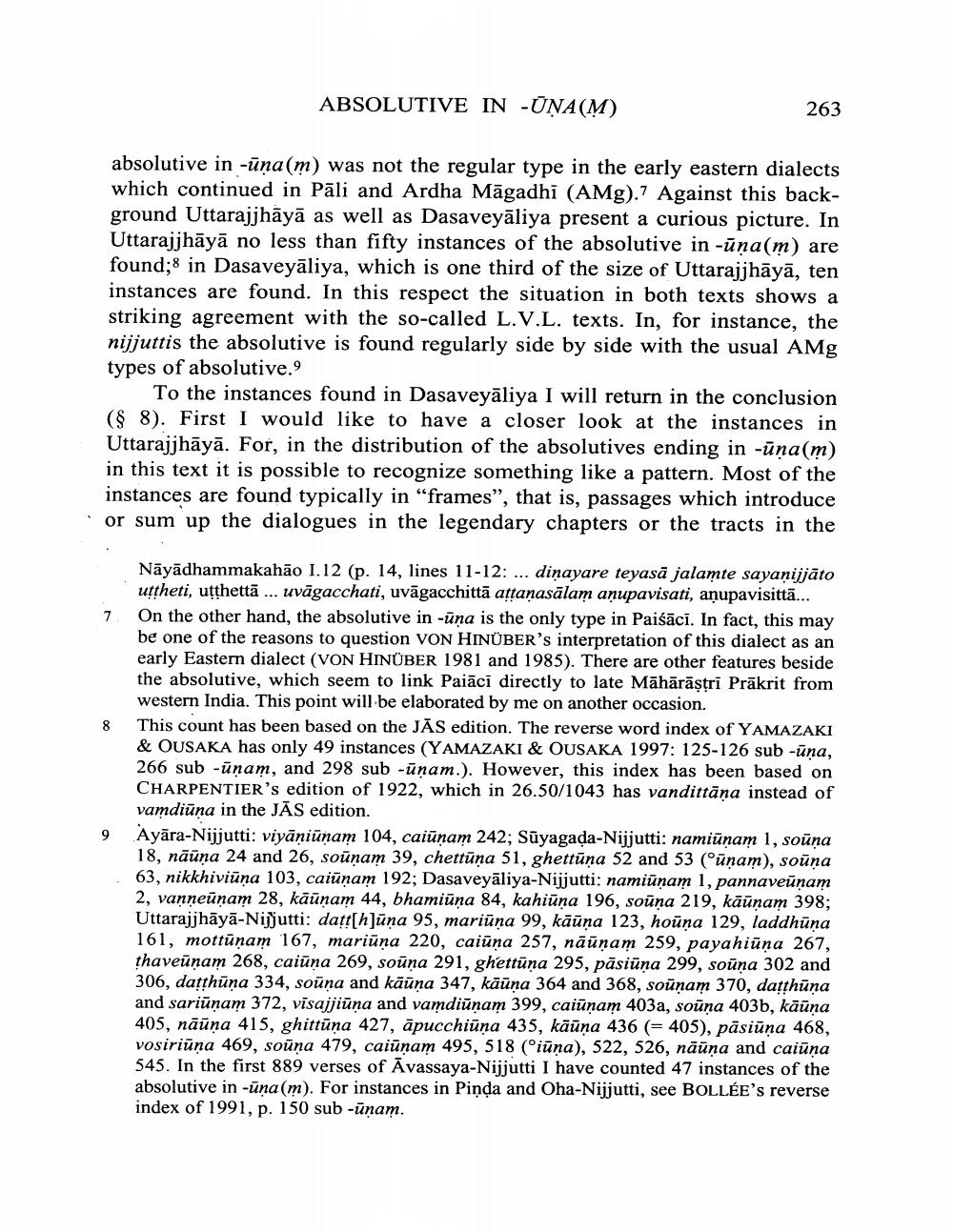Book Title: Distribution Of Absolutive In Una In Ittarajjhaya Author(s): Herman Tieken Publisher: Herman Tieken View full book textPage 3
________________ ABSOLUTIVE IN UNA(M) absolutive in -una(m) was not the regular type in the early eastern dialects which continued in Päli and Ardha Magadhi (AMg). Against this background Uttarajjhāyā as well as Dasaveyāliya present a curious picture. In Uttarajjhäyä no less than fifty instances of the absolutive in -una(m) are found; in Dasaveyāliya, which is one third of the size of Uttarajjhāyā, ten instances are found. In this respect the situation in both texts shows a striking agreement with the so-called L.V.L. texts. In, for instance, the nijjuttis the absolutive is found regularly side by side with the usual AMg types of absolutive." To the instances found in Dasaveyäliya I will return in the conclusion (§ 8). First I would like to have a closer look at the instances in Uttarajjhäyä. For, in the distribution of the absolutives ending in -una(m) in this text it is possible to recognize something like a pattern. Most of the instances are found typically in "frames", that is, passages which introduce or sum up the dialogues in the legendary chapters or the tracts in the 7 263 9 Näyädhammakahão 1.12 (p. 14, lines 11-12:... dinayare teyasä jalamte sayaṇijjāto uttheti, utthettä... vägacchati, uvägacchittä attaṇasālam aṇupavisati, anupavisittä... On the other hand, the absolutive in -una is the only type in Paiśācī. In fact, this may be one of the reasons to question VON HINÜBER's interpretation of this dialect as an early Eastern dialect (VON HINÜBER 1981 and 1985). There are other features beside the absolutive, which seem to link Paiaci directly to late Māhārāṣṭri Prakrit from western India. This point will be elaborated by me on another occasion. 8 This count has been based on the JAS edition. The reverse word index of YAMAZAKI & OUSAKA has only 49 instances (YAMAZAKI & OUSAKA 1997: 125-126 sub -ūņa, 266 sub -ūņam, and 298 sub -ūņam.). However, this index has been based on CHARPENTIER'S edition of 1922, which in 26.50/1043 has vandittāṇa instead of vamdiuna in the JĀS edition. Ayara-Nijjutti: viyäniünam 104, calunam 242; Süyagada-Nijjutti: namiūnam 1, souna 18, näūna 24 and 26, sounam 39, chettuna 51, ghettuna 52 and 53 ("unam), soūna 63, nikkhiviūna 103, caiunam 192; Dasaveyäliya-Nijjutti: namiūnam 1, pannaveūṇam 2, vanneūņam 28, kāūņam 44, bhamiūna 84, kahiūņa 196, soūņa 219, kāūņam 398; Uttarajjhāyā-Nijjutti: darr[h]üna 95, mariūṇa 99, kāūna 123, hoûna 129, laddhūna 161, mottunam 167, mariûna 220, calūna 257, nāūnam 259, payahina 267, thaveūnam 268, caiûna 269, soûna 291, ghettuna 295, päsiûna 299, souna 302 and 306, daṭṭhūņa 334, soūņa and kāūņa 347, kāūņa 364 and 368, souṇam 370, daṭṭhūna and sariūnam 372, visajjiūna and vamdiūṇam 399, caiüṇam 403a, soûna 403b, kāūna 405, näûna 415, ghittüna 427, apucchiûna 435, käūņa 436 (= 405), pasiūna 468, vosiriūņa 469, soūņa 479, caiunam 495, 518 (°iūna), 522, 526, nāūna and caiūṇa 545. In the first 889 verses of Avassaya-Nijjutti I have counted 47 instances of the absolutive in -ūņa (m). For instances in Pinda and Oha-Nijjutti, see BOLLÉE's reverse index of 1991, p. 150 sub -ūņam.Page Navigation
1 2 3 4 5 6 7 8 9 10 11 12 13 14 15 16 17 18 19 20 21 22 23 24 25 26
